|
Advantech PPC-L158T
Intel Atom D525-powered, versatile fanless 15-inch Panel PC for a variety of industrial and commercial applications where consistently reliable operation matters
review by Conrad H. Blickenstorfer -- photography by Carol Cotton
Panel PCs like the Advantech PPC-L158T are designed to bring computing to all sorts of places where a desktop or notebook computer isn't feasible or just won't do. That's places like factories, warehouses, distribution and control centers, terminals or other demanding environments that are hard on equipment, and demand superior reliability and 24/7/365 uptime to boot. Systems integrators use this type of hardware in all sort of industrial equipment, as point-of-information terminals, interactive kiosks, point-of-sale systems, commercial gaming platforms, medical projects, and numerous other applications.
Utility is where it's at with Panel PCs, and so they are usually configured as compact, sturdy boxes with display sizes ranging from very small to quite large, usually in the 6 to 19-inch range. These machines are full-function PCs although most are used to do just one thing. Application and operating environment dictate size, features and performance. With a 15-inch display, the Advantech PPC-L158T is among the larger panels, and its all-in-one design makes it more of a general purpose product than some of the more specialized designs.
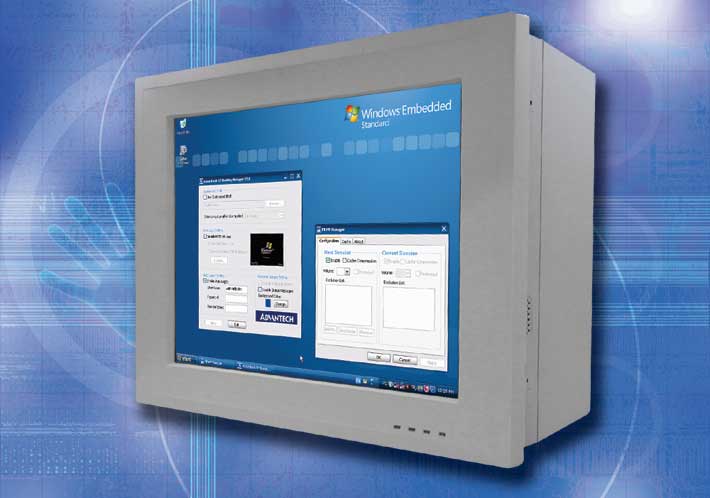
Given that today's notebooks have 17-inch displays, the Advantech panel's 15-inch screen isn't very large, but the machine itself is quite substantial. Measuring 15.6 x 12.5 x 4.1 inches and sporting the compact, rational design common to all panel computers, the PPC-L158T weighs over 13 pounds. The display uses the conventional 4:3 aspect ratio, has an analog 5-wire resistive touchscreen, and offers wide horizontal (160 degrees) and vertical (140 degrees) viewing angles for comfortable use. Viewability under all lighting conditions is augmented by anti-glare coating and strong 350-nit backlight (your average notebook computer has less than 200 nits).
Unlike mobile notebook and tablet computers that require a careful balance between performance, size, weight and power consumption, Panel PCs are usually A/C-powered and have fewer size and weight constraints. The emphasis here is on quiet, reliable operation and simply getting the job done. That often means tried-and-true components and a minimal number of potential points-of-failure. Cost effectiveness is an issue, too, and so companies like Advantech generally offer fairly broad product lineups, made even broader by the availability of different colors, mounting options, software configurations, and even customization for use in tough environments.
In Advantech's Panel PC lineup, models are generally classified as either PPC-xxxT multi-functional Panel PCs or PPC-LxxxT fanless panel PCs where the first to two x's also indicate the display size. So the PPC-157T we reviewed a couple of years ago was a multi-functional unit with a 15-inch screen whereas the PPC-L158T in this article is a fanless panel PC with the same size 15-inch screen.
Since many Panel PCs are used as HMI (Human Machine Interface) systems, they must have sufficient onboard connectivity to interface with the machinery they are supposed to monitor and control. The PPC-L158T provides both current systems and legacy systems support with four USB 2.0 ports, two RS232 serial ports, another that supports RS232/422/485, and a fourth that can be used for GPIO. There is also a VGA port for potential large/secondary screen applications, and dual Gigabit Ethernet jacks for communication with backend servers. Dual IEEE 1394 ports are optionally available for multimedia applications.
OS and Performance
The amount of processing power needed to make a computer fast enough depends entirely on what it is supposed to do, and to a lesser extent on what type of operating system it runs. A general purpose OS such as Microsoft Windows 7 must be able to do a vast variety of possible tasks. Therefore, they are large and need quite a bit of storage and processing power. Panel PCs usually do just fine with much less processing power because they generally perform a small number of well defined tasks, nothing more and nothing less. That, however, doesn't mean that customers and system integrators may not have very different requirements, and so the PPT-L158T can be ordered with Windows XP, Windows 7, the embedded version of each, and even Windows CE. CE and the embedded versions obviously have a much smaller footprint and much lower resource requirements.
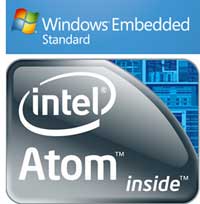 For a processor, Advantech chose a chip that is both very economical, but also powerful enough to drive full OS 7. That'd be the dual-core Intel Atom D525 which together with the D510 was introduced in December of 2009 as an economical solution for low-end desktop computers. It has Intel Graphics Media Accelerator 3150-based integrated graphics, and compared to the original Atom designs, the chip count is down from three to two. The graphics core is running at a respectable 400MHz, compared to just 200MHz in the Atom N450 of the same Atom generation, the chip that powered many millions of netbooks. For a processor, Advantech chose a chip that is both very economical, but also powerful enough to drive full OS 7. That'd be the dual-core Intel Atom D525 which together with the D510 was introduced in December of 2009 as an economical solution for low-end desktop computers. It has Intel Graphics Media Accelerator 3150-based integrated graphics, and compared to the original Atom designs, the chip count is down from three to two. The graphics core is running at a respectable 400MHz, compared to just 200MHz in the Atom N450 of the same Atom generation, the chip that powered many millions of netbooks.
The Atom D510 and D525 have a TDP (thermal design power) rating of 13 watts, which is a lot more than the roughly two watts most of the mobile Atom chips draw. Since the PPC-L158T is always be plugged in (there is no internal battery), the higher (albeit still low) power draw makes no difference, especially since the unit's large heat sink easily handles the thermal load. Note that the D525 runs at 1.8GHz whereas the D510 clocks at 1.66GHz. processor. Else, the two chips are essentially the same, except that the slightly newer D525 can use faster and more energy-efficient DDR3 memory.
To show where the L158T stands in terms of relative performance, we ran our standard benchmark suites on it. We're also listing the results of the Core 2 Duo powered Advantech PPC-157T we tested in 2010, the Advantech UTC-520 touch terminal that uses the D510 (see here), and finally the Advantech PIT-1501W (see here), a patient infotainment terminal with a first generation Atom processor we tested in 2010. Here's how the devices compare:
|
PERFORMANCE COMPARISON PASSMARK
|
PPC-L158T
|
PPC-157T
|
UTC-520
|
PIT-1501W
|
|
Intel Processor
|
Atom D525
|
Core 2 Duo T7400
|
Atom D510
|
Atom Z530
|
|
Product type
|
Panel PC
|
Panel PC
|
Touch terminal
|
Touch terminal
|
|
Clock speed
|
1.80GHz
|
2.16GHz
|
1.66GHz
|
1.6GHz
|
|
Thermal Design Power (TDP)
|
13.0 watts
|
34.0 watts
|
13.0 watts
|
2.3 watts
|
|
CPU Mark
|
552.2
|
1292.1
|
512.9
|
244.4
|
|
2D Graphics Mark
|
149.7
|
285.8
|
173.8
|
108.3
|
|
Memory Mark
|
254.8
|
552.3
|
245.2
|
215.3
|
|
Disk Mark
|
496.7
|
459.6
|
431.3
|
162.1
|
|
3D Graphics Mark
|
13.5
|
37.8
|
12.4
|
18.3
|
|
Overall PassMark
|
316.9
|
584.7
|
294.7
|
154.5
|
PERFORMANCE COMPARISON
CRYSTALMARK 2004R3
|
PPC-L158T
|
PPC-157T
|
UTC-520
|
PIT-1501W
|
|
ALU
|
12,992
|
19,311
|
11,309
|
5,323
|
|
FPU
|
9,667
|
22,560
|
9,347
|
4,678
|
|
MEM
|
8,095
|
10,867
|
7,778
|
3,853
|
|
HDD
|
9,112
|
8,231
|
7,087
|
5,058
|
|
GDI
|
2,804
|
4,679
|
2,270
|
2,321
|
|
D2D
|
4,242
|
3,015
|
3,693
|
859
|
|
OGL
|
793
|
2,272
|
711
|
317
|
|
Overall CrystalMark
|
47,705
|
70,935
|
42,195
|
22,409
|
Note that benchmarks often generate weird results that do not seem to fit in. That's because they have a hard time generating directly comparable results over different processor architectures, operating systems, and storage technologies. However, overall summary results almost always provide a good idea of the relative performance of a product, and it's no different here. You can see that the Core 2 Duo-powered PPC-157T is significantly faster and more powerful than any of the low power Atoms, but it is also rated at 2.5 times the thermal design power of the D525. The D525 and D510 devices are close as we expected, with the slightly quicker clock speed of the D525 more or less accounting for the difference. The original Z530 chip in the PIT-1501W is considerably slower.
What the benchmark results of the PPC-L158T mean, overall, is that the panel, in our configuration, performed at about the level of a late generation netbook, and tens of millions of those were sold.
Enhanced Write Filter
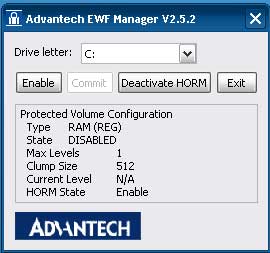 The Advantech Enhanced Write Filter Manager was installed on our test machine and I'll briefly describe it as it'll be of interest to many potential users of the PPC-L158T. Enhanced Write Filter, or EWF, is an interesting security feature supported by the Windows Embedded operating systems. The Advantech Enhanced Write Filter Manager was installed on our test machine and I'll briefly describe it as it'll be of interest to many potential users of the PPC-L158T. Enhanced Write Filter, or EWF, is an interesting security feature supported by the Windows Embedded operating systems.
What the Enhanced Write Filter does is provide the ability to write-protect a run-time image. It does that by redirecting write operations to another storage location and totally write-protects the run-time image, thus preventing any damage that might be caused by an unexpected power failure, vibration or even a virus attack.
Taking full advantage of EWF technology requires some studying and proper configuration of a system. To learn more about this particular feature of Windows Embedded, read the EFW Manager and EWF Components sections at the Microsoft Embedded Developer Center.
Straightforward design
Panel PCs are, for the most part, designed to be reliable, utilitarian tools for industrial jobs. The emphasis is on simplicity and functionality rather than eye-catching design. The picture below shows the PPC-L158T from the front and all four sides. The front bezel and housing are tough beige plastic, the chassis inside is all steel. There are cooling slots and a few other openings indicating that that this is, with the exception of the IP65-protected front bezel, not a sealed system.
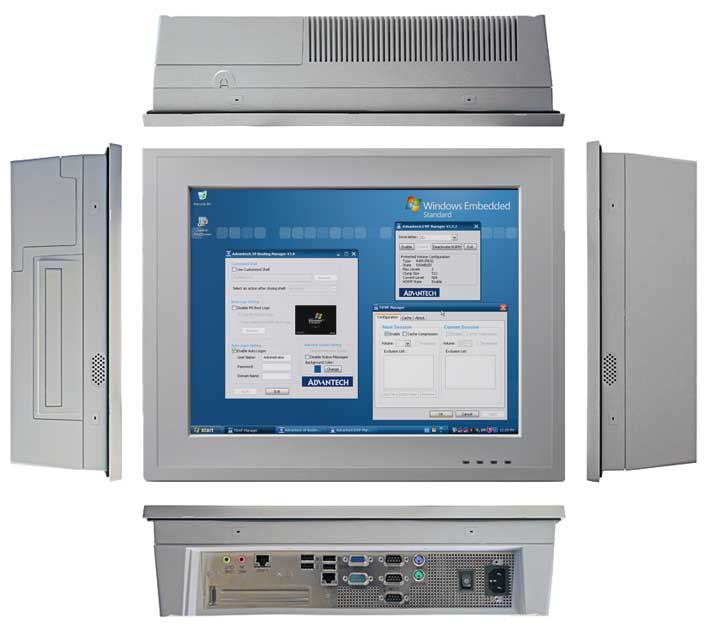
Looking at the four sides, you can see that all wired connectivity is concentrated along the bottom side, facing down. The sole exception is the optional optical drive on the left (which was not installed in our unit).
At this point we normally show pictures of what it looks like inside the unit, so that we can explain components and their arrangement as well as give potential customers an idea of what to expect in terms of expandability, access and service. In this case, Advantech asked us not to open the unit. So all we can say is that the interior consists of three sections, one for the internal power supply, one for the system board with its substantial finned cooling sink, and one for the hard disk and expansion space for the optical drive. Everything is as neat and clean as we've come to expect from Advantech.
Touch panel
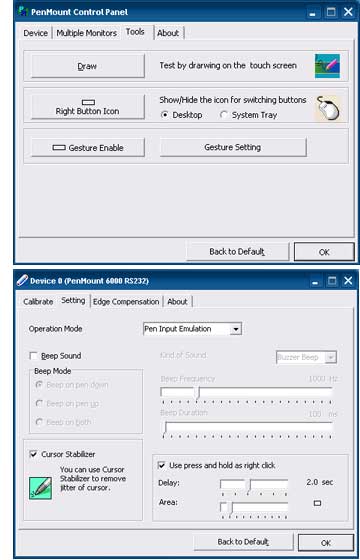 Our Advantech PPC-L158T review unit had the optional 5-wire analog resistive touchscreen with a serial interface. It uses the PenMount 6000 Controller Chipset. The touch screen itself is a heavy-duty unit that is rated at 35 million depressions. The resistive touch screen can be operated either with any stylus or with a finger. Like the touch screens used in other Advantech products, this one is very smudge-resistant, a quality that's much appreciated in daily use. Our Advantech PPC-L158T review unit had the optional 5-wire analog resistive touchscreen with a serial interface. It uses the PenMount 6000 Controller Chipset. The touch screen itself is a heavy-duty unit that is rated at 35 million depressions. The resistive touch screen can be operated either with any stylus or with a finger. Like the touch screens used in other Advantech products, this one is very smudge-resistant, a quality that's much appreciated in daily use.
The unit comes with a PenMount Control Panel that let's you calibrate the touchscreen using 4, 9, 16, or 25 points, with 25 points offering maximum accuracy. A "Draw" mode provides digitizer statistics and can be used for debugging. An option menu lets you set the operation mode either to stream mode or point mode.
The control panel has a special screen for edge compensation. Edge compensation can be very important for precise calibration. With touch screens and digitizers it can be difficult to touch or select items at the edge of the panel, especially when the display runs all the way to the kind of thick protective bezel most rugged panels have. The L158T's panel allows you to precisely define edge compensation for all four sides, i.e., set it so the cursor thinks the edge is either farther away or closer in. Precise configuration can make for optimal usability and responsiveness in touch applications.
In the panel's Setting menu you can configure touch mode to work either in mouse emulation or to simply issue a click on touch. You can also enable press-and-hold for right mouse clicks and fine-tune right mouseclick operation, setting both the delay and the size of the click area.
You can also enable a beep sound to occur on pen down or pen up (or both), and even set its frequency and duration. This may sound strange, but in noisy shop floor operation, having auditory feedback to confirm a touch operation may come in handy.
In applications that use multiple monitors, the PenMount Control panel let's you configure multiple monitor support and map the touch screens.
Why is all of this important? Because having the proper tools to precisely configure a touch screen for an application can make or break its utility and usability. And with touch screen vendors now adding multi-touch/multi-finger operation, this will only become more important.
If resistive touch is not suitable for an application, Advantech's multi-functional panels can also be shipped with a capacitive or a surface acoustic wave (SAW) touchscreen. This adds even more flexibility to an already highly versatile and configurable systems, but we're not sure if those types of touch screens are also available with the L158T.
Power
As a panel PC with ready access to external power, the PPC-L158T does not have a battery and runs on external A/C power instead. Its integrated power supply can handle 10 to 240 Volt input at 50 or 60Hz, and provides a maximum of 85 watt output.
Storage and expansion
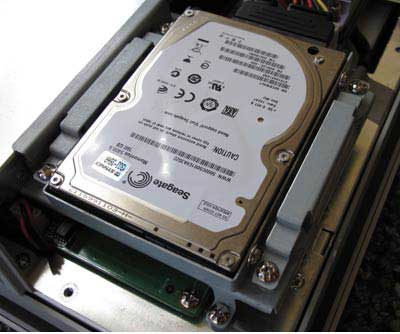 As a full-function panel PC, the Advantech PPC-L158T has an internal hard disk bay that can accommodate standard 2.5-inch disks. As a full-function panel PC, the Advantech PPC-L158T has an internal hard disk bay that can accommodate standard 2.5-inch disks.
Our review machine came with a 160GB Seagate Momentus ST9160314AS with a speedy 3Gb/second SATA interface. It's spinning at 5,400 RPM and is quite power-efficient, using about 1.4 watts idling and about 1.8 watts operating. The disk's operating temperature range is 32 to 140 degrees Fahrenheit and it can handle operating shocks up to 350Gs. 250GB and 500GB SATA disks are optionally available.
As if the disk's inherent shock-resistance were not impressive enough, the disk itself is mounted in a floating metal case that is then suspended via soft silicone bushings in a very cleverly designed subframe caddy, giving it excellent protection against shock and vibration.
The device supports a CFast Type II slot and, depending on the application and OS, software may be on a card instead of on disk. In units with hard disks, the CF Card slot is not used and can presumably available for other purposes.
Depending on the application, the PPC-L158T can be configured with an optional optical disc drive kit that may contain a SATA DVD writer.
Ruggedness
As a panel PC, the Advantech PPC-L158T has different ruggedness requirements than a mobile computer. It's not likely to get dropped since it will be installed in a panel or other stationary setting. And since it is most likely used indoors, it won't get rained on. However, it is expected to run reliably 24/7 in factory settings where temperature, vibration, and exposure to water still can be issues.
As a result, the PPC-L158T is sturdy and very well built. The industrial plastic bezel and housing won't easily scratch or break. When mounted in a panel, a neoprene gasket behind the bezel lip effectively seals the computer. So while the housing itself has ventilation slots and standard connectors, from the front the system carries the equivalent of IP65 sealing. This means that a panel with the PPC-L158T installed could be hosed down and not incur any damage.
In terms of operating temperature, panels are not generally installed freezers, and so the device is designed to operate within a range of 32 to 122 degrees Fahrenheit, well beyond the range where human operators can comfortably work.
Advantech does provide shock test figures and certifies the panel to 10G peak acceleration for a duration of 11 msec.
Bottom line: Advantech PPC-L158T fanless Panel PC
The Advantech PPC-L158T is a versatile industrial panel computer from an experienced Taiwanese embedded and industrial systems manufacturer with a worldwide presence. Its power-efficient dual-core 1.8GHz Intel Atom D525 processor generates so little heat that the unit does not require a fan.
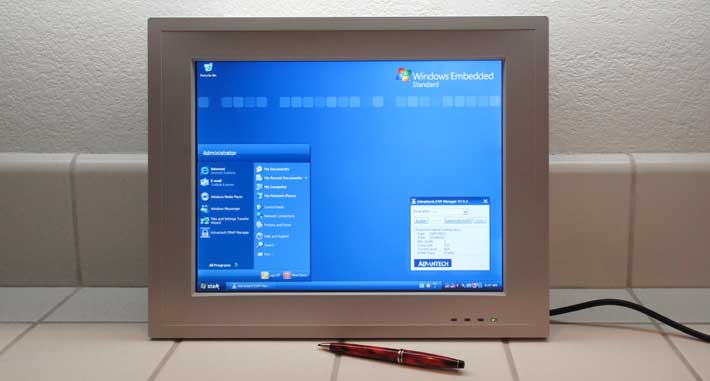
The PPC-L158T can be configured either as an embedded device running one of the Windows Embedded operating systems on disk or Compact Flash, or as a full Windows 7 or XP machine using the internal SATA hard disk. The unit comes with up to a 4GB of DDR3 RAM and can also accommodate an optional optical drive. The Atom D525 processor should provide adequate performance for applications this type of Panel PC is intended for. When mounted in a panel, the PPC-L158T's front bezel is sealed to IP65 specifications. The unit is designed to handle the abuse (shock, temperature, humidity, etc.) likely encountered in an industrial environment.
Advantech offers panel computers with a wide variety of screen sizes and touchscreen technologies. The L158T with its large 15-inch display with 4:3 aspect ratio is designed to fit into tight spaces. The display has excellent anti-glare properties and is almost totally immune to smudges and fingerprint. Our test unit had the optional resistive touch screen that was very responsive and highly configurable for optimal use with both a stylus or fingers.
The PPC-L158T offers excellent onboard connectivity for use with a variety of current or legacy devices and peripherals. You get four external USB 2.0 USB ports, four RS232 and RS232/422/485/TTL serial ports, video for an external monitor, and dual LAN. There is also support for a CF/CFast Card slot (used for the OS in non-HD systems) and internal PCI/mini-PCI/mini-PCIe slots that can be used for additional expansion.
The PPC-L158T is a cleanly designed, powerful panel computer that combines versatility, ruggedness, easy customization and maintenance, and enough performance. It can be configured for a large variety of applications in all kinds of manufacturing and industrial settings, with application in numerous other settings as well.
-- Conrad H. Blickenstorfer, September 2012
Advantech PPC-L158T Specs:
| Type |
Fanless Panel PC
|
| OS |
Microsoft Windows Embedded Standard 7, XP Embedded/XP Pro, Vista, Windows 7, and CE6.0
|
| Processor |
Intel Atom D525, 1MB L2 cache
|
| Clock speed |
1.80Hz
|
| Thermal Design Power |
13 watts
|
| Chipset |
Intel ICH8M
|
| Memory |
2 x DDR3 800 MHz SODIMMs (up to 2GB each socket), compatible with 1066/1333 MHz (does not support ECC and REG) |
| Display |
15" XGA (1024 x 768) color TFT with 160/140 degrees viewing angle, 350 nit backlight (50,000 hour backlight lifetime)
|
| Digitizer |
Analog resistive 5-wire (AMT) anti-corrective type |
| Keyboard |
Optional external USB |
| Storage |
HDD bay for shock-mounted 2.5-inch SATA/300 disk (test machine had 160GB 5,400rpm Seagate Momentus); CFast Type I/II socket
|
| Optional storage |
Optional optical drive bay for SATA DVD/CD-RW or SATA DVD+/-RW drive
|
| Expansion slots |
1 PCI/PCIe, 1 Mini-PCIe, 1 CF Card Type 2; optional PCI
|
| Housing |
Plastic bezel and enclosure, metal case, with 75 and 100mm VESA-standard mounting |
| Size (inches) |
15.6 x 12.5 x 4.1 inches (397 x 318 x 104 mm) |
| Weight |
13.2 pounds as tested
|
| Operating temperature |
32 to 122 degree Fahrenheit |
| Ingress protection |
IP65 (front panel only) |
| Shock |
10 G peak acceleration (11 msec duration) |
| Vibration |
1G |
| EMC |
BSMI, CE, FCC Class B |
| Safety |
CE CB, UL, BSMI, CCC, VCCI |
| Humidity |
10-95% non-condensing |
| Power |
100-240 Volt DC |
| Interface |
External: 4 USB 2.0, 1 RS-232/422/485, 2 RS-232, 1 RS-232/GPIO (8 channels, TTL level), 2 x RJ45 LAN (10/100/100), audio in/out/mic, VGA, 2 x PS/2 (mouse and kbd); optional: 2 x IEEE 1394 |
| Wireless options |
Flexible expansion capability via Mini-PCI or Mini-PCIe
|
| Price |
Inquire |
| Web |
Advantech www.advantech.com.tw |
| Product page |
Advantech |
| Product brochure |
Advantech PPC-L158T (PDF) |
| Prince |
Starting at US$1,365 (see online store) |
(copyright 2012 RuggedPCReview.com)
Advantech Corporation
13 Whatney
Irvine, CA 92618
Toll Free: 1-800-866-6008
Ph: 949-420-2500
Fax: 949-420-2501
www.advantech.com
Advantech Co. Ltd.
No.1, Alley 20, Lane 26, Rueiguang Road
Neihu District, Taipei Taiwan 114, R.O.C.
Tel: 886-2-2792-7818
Fax: 886-2-2794-7301
www.advantech.com
|



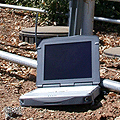

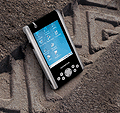
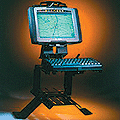






 For a processor, Advantech chose a chip that is both very economical, but also powerful enough to drive full OS 7. That'd be the dual-core Intel Atom D525 which together with the D510 was introduced in December of 2009 as an economical solution for low-end desktop computers. It has Intel Graphics Media Accelerator 3150-based integrated graphics, and compared to the original Atom designs, the chip count is down from three to two. The graphics core is running at a respectable 400MHz, compared to just 200MHz in the Atom N450 of the same Atom generation, the chip that powered many millions of netbooks.
For a processor, Advantech chose a chip that is both very economical, but also powerful enough to drive full OS 7. That'd be the dual-core Intel Atom D525 which together with the D510 was introduced in December of 2009 as an economical solution for low-end desktop computers. It has Intel Graphics Media Accelerator 3150-based integrated graphics, and compared to the original Atom designs, the chip count is down from three to two. The graphics core is running at a respectable 400MHz, compared to just 200MHz in the Atom N450 of the same Atom generation, the chip that powered many millions of netbooks.
 The Advantech Enhanced Write Filter Manager was installed on our test machine and I'll briefly describe it as it'll be of interest to many potential users of the PPC-L158T. Enhanced Write Filter, or EWF, is an interesting security feature supported by the Windows Embedded operating systems.
The Advantech Enhanced Write Filter Manager was installed on our test machine and I'll briefly describe it as it'll be of interest to many potential users of the PPC-L158T. Enhanced Write Filter, or EWF, is an interesting security feature supported by the Windows Embedded operating systems.

 Our Advantech PPC-L158T review unit had the optional 5-wire analog resistive touchscreen with a serial interface. It uses the PenMount 6000 Controller Chipset. The touch screen itself is a heavy-duty unit that is rated at 35 million depressions. The resistive touch screen can be operated either with any stylus or with a finger. Like the touch screens used in other Advantech products, this one is very smudge-resistant, a quality that's much appreciated in daily use.
Our Advantech PPC-L158T review unit had the optional 5-wire analog resistive touchscreen with a serial interface. It uses the PenMount 6000 Controller Chipset. The touch screen itself is a heavy-duty unit that is rated at 35 million depressions. The resistive touch screen can be operated either with any stylus or with a finger. Like the touch screens used in other Advantech products, this one is very smudge-resistant, a quality that's much appreciated in daily use.
 As a full-function panel PC, the Advantech PPC-L158T has an internal hard disk bay that can accommodate standard 2.5-inch disks.
As a full-function panel PC, the Advantech PPC-L158T has an internal hard disk bay that can accommodate standard 2.5-inch disks.
